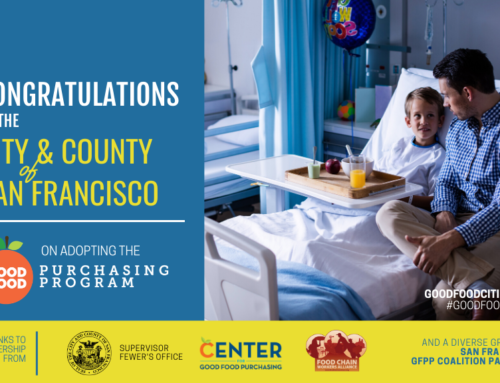Many food service institutions in the Bay Area can point to items on their menu to show that they offer healthy, sustainable and fairly made food. But it’s often unclear how deep that commitment goes across the menu as a whole. San Francisco Unified School District (SFUSD), with its $11 million annual school food budget, just pledged to make that commitment clearer and stronger.
In late May, SFUSD’s School Board voted unanimously to analyze its food procurement against the criteria of the Good Food Purchasing standards and develop a plan to meet benchmarks laid out in those standards by fall of 2017. By doing so, the district demonstrated its commitment to not only meeting the nutritional needs of its students, but also its desire to ensure that the district’s procurement dollars have as positive an impact as possible.
The Good Food Purchasing standards, which are administered by the Center for Good Food Purchasing, developed out of a multi-year effort led by the Los Angeles Food Policy Council. Recognizing that it’s very difficult for any one food service director to analyze the impacts of their many food choices, the LA Food Policy Council simplified things. They developed a set of criteria based on existing standards with various levels of stringency, creating a tiered, points-based framework that is similar to LEED, the green building standard.
The Good Food Purchasing standards encompass five categories of review:
- Local: Encourages purchasing from local farms and food processors
- Sustainable: Emphasizes farming, ranching and fishing methods that minimize pesticide usage and antibiotics, are organically certified and avoid depletion of fishing stocks
- Fair: Encourages procurement from companies without labor violations and those that support unionized workforces, fair trade contracts or similar agreements with workers
- Humane: Prioritizes farms that can demonstrate third-party certification of their humane treatment of animals, such as the Animal Welfare Approved label
- Healthy: Emphasizes nutritious dishes and snack items in place of sugary and highly processed items.=
For more details about the guidelines and criteria, see the school board resolution.
One factor that will be crucial to the success of SFUSD’s effort is the analytical and staff support provided by the Center for Good Food Purchasing. Since its inception, the organization has developed a database with information about hundreds of food vendors that allows it to quickly analyze information provided by distributors and food service contractors. They are partnering with SFUSD’s office of Student Nutrition Services to review the data that the school district will obtain from its vendors and help produce the baseline assessment due in a year.
SPUR supported the School Board’s decision to make SFUSD one of the first public institutions in the nation to embrace the Good Food Purchasing Program. We look forward to seeing the results of the baseline assessment and the district’s subsequent action plan. In the meantime, we see even greater potential for change if other public institutions that feed thousands of people — such as hospitals and jails — also adopt the Good Food Purchasing program. We are hopeful that other agencies in San Francisco and other school districts across the region will follow in SFUSD’s footsteps in embracing a thoughtful framework for improving food procurement.





